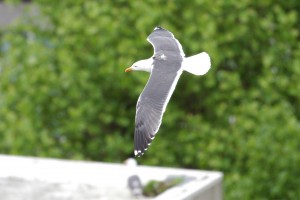Flight energetics of urban Lesser black-backed gulls: a case study for bio-inspired (flight/UAV) technology
Species: Lesser Black-backed Gull
City environments are drastically different from the natural environment of most bird species, yet some species are able to exploit urban landscapes very successfully. Over the last 40 years Lesser Black-back Gull populations have increased dramatically in many UK cities, establishing large urban nesting populations. Reasons behind this sudden increase are unclear and little is known about the ecology of these urban nesting populations. Lower flight costs and/or better living conditions such as less predators, higher temperature and human waste as a food source might be possibilities for this increase. Analysing flight energetics of urban gulls in combination with food rewards and breeding success could increase our understanding of why these gulls are living in urban areas.
Air flows in cities are highly complex, with areas of updraught and downdraught. It appears gulls are able to take advantage of the complex air flow to reduce the cost of their flight and have no trouble maintaining control whilst navigating through turbulent regions. By comparison Unmanned Air Vehicles of a similar size and weight are restricted in endurance and range due to current battery technology and often face destabilisation in turbulence. Understanding how gulls optimise navigation in urban airscapes could provide insight for path planning in UAV technology.
This project started in 2016 and is part of a larger European Research Council (ERC) funded program looking at bird inspired technologies for autonomous flight. There are two main focusses of this project:
1. Bio-inspired path planning for Unmanned Air Vehicles in Urban Environments. Analysing the flight paths of urban gulls for energy expenditure and optimisation criteria by combining simplified CFD models of Bristol with an aerodynamic bird flight model. The optimisation criteria can be used to develop control schemes suitable in path planning for gull-sized UAVs in order to improve flight performance and avoid turbulence.
2. Foraging behaviour and flight costs of urban gulls. Comparing behaviour and energetic costs of gulls living in urban environments gull population in traditional rural areas by combining GPS with accelerometer data, land use and wheather conditions.
In the summer of 2016 and 2017 we deployed UvA BiTS GPS loggers on 11 Lesser Black-backed gulls. These trackers provide location, altitude, speed and 3D acceleration data over the whole period (2016-2020). From the 3D acceleration data, specific gull behaviours have been calculated. Additionally, habitat, elevation and wheather conditions maps of Bristol and surrounding areas have been created.
Please follow us and the urban gulls on their own twitter account @UrbanGulls!
Contact Persons:
Dr. Shane Windsor – Shane.Windsor@bristol.ac.uk
For colour-ring information contact: Peter Rock (pete.rock@urbangulls.com)





